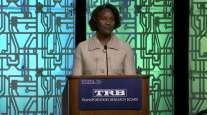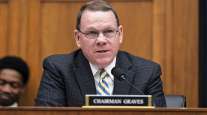House Democrats Push for Infrastructure in Next Coronavirus Bill

[Stay on top of transportation news: Get TTNews in your inbox.]
House Speaker Nancy Pelosi said the next coronavirus stimulus bill should include at least $760 billion over five years for water projects, broadband and transportation — plus $10 billion for community health centers and more for housing and education — as a way to strengthen U.S. infrastructure and the economy.
“We need to invest in our infrastructure to address some of the critical impacts and vulnerabilities that have been laid bare by the coronavirus,” Pelosi said April 1 on a call with reporters.
Pelosi has said the $2.2 trillion package signed into law last week, Congress’s third virus-related bill, was aimed at rescuing the U.S. economy as businesses close and people stay home amid the widening outbreak. The next measure — the fourth phase of virus response, which Congress plans to take up after April 20 — will be intended to stimulate an economic rebound, she said.
Pelosi and other Democrats raised concerns April 1 that the epidemic will exacerbate inequality in access to health care and in the ability of people to keep working or going to school while following social distancing guidelines. House Majority Whip Jim Clyburn (D-S.C.) said the virus response should focus on “equitable” recovery, unlike stimulus measures to respond to the 2008 recession and the Great Depression.
“I am very concerned that things are going to get worse in rural and poor areas” that don’t have internet access or community health centers, Clyburn said.
Paying for It
The total cost for this part of Democrats’ phase-four virus proposal would exceed the $760 billion infrastructure plan they released in late January, by adding $10 billion for health care centers and additional funds for housing and education, Pelosi said. That plan didn’t include how to pay for it, which has been the subject of talks between House Ways and Means Chairman Richard Neal and Treasury Secretary Steven Mnuchin.
On the April 1 call, Democrats said they want to invest $40 billion to improve local water quality and $86 billion to expand broadband access. Their plan would also include funds to modernize the electric grid and rebuild roads, bridges and public transit.
With interest rates for the United States being at ZERO, this is the time to do our decades long awaited Infrastructure Bill. It should be VERY BIG & BOLD, Two Trillion Dollars, and be focused solely on jobs and rebuilding the once great infrastructure of our Country! Phase 4 — Donald J. Trump (@realDonaldTrump) March 31, 2020
The House speaker said her proposal is “probably in the same ballpark” of what President Donald Trump called for on March 31. He said he wants a $2 trillion infrastructure package, financed by borrowing at currently low interest rates, which would be about the same as Democrats’ plan if spread over 10 years.
Democrats, who took control of the House last year, have generally been more interested in federal infrastructure projects than the Republicans who controlled both chambers of Congress for the first two years of the Trump administration. Trump had pledged in his 2016 campaign to seek $1 trillion in infrastructure spending and called on Congress in his 2018 State of the Union address to dedicate $1.5 trillion in new investment.
“We are so pleased that the president has returned to his interest in it,” Pelosi said April 1 of Trump’s infrastructure tweet.

President Trump. (Stefani Reynolds/Bloomberg News)
Infrastructure talks stalled last year after Democrats said the White House would release a plan to pay for as much as $2 trillion in infrastructure. That discussion broke down when Democrats said Trump demanded that they halt investigations of the president and his businesses.
Democrats have been reluctant to release a plan to pay for infrastructure without the White House also assuming some political risk for what would be an expensive proposal.
Senate Prospects
Transportation and Infrastructure Chairman Peter DeFazio, a Democrat from Oregon, said he was “pleased to see the president has come back to where we started about a year ago,” even though Republican leaders in Congress don’t share the same enthusiasm for expensive public works.
Senate Majority Leader Mitch McConnell said March 31 that he prefers to see what effect Congress’s third virus bill has on the economy before moving ahead with another stimulus.
“What I disagree with the speaker on is she’s already saying we need to work on phase four. Well look, the current law has not been in effect for even a week yet,” McConnell said in a radio interview.
The stimulus legislation, which at $2.2 trillion was the largest in U.S. history, was focused on direct payments to lower- and middle-class individuals, expanded unemployment insurance, and loans and grants to help companies of all sizes cover expenses during the health crisis.
Environment and Public Works Chairman John Barrasso (R-Wyo.) has called for his $287 billion surface transportation renewal bill to be part of the next coronavirus package.
Want more news? Listen to today's daily briefing:




